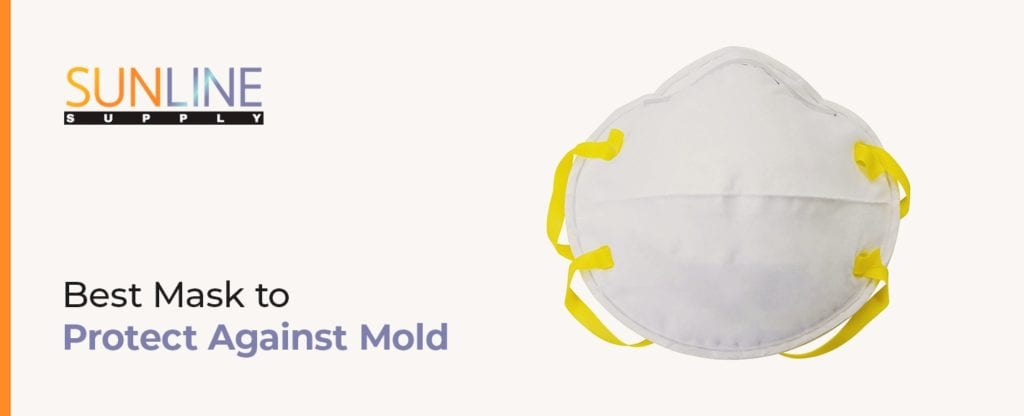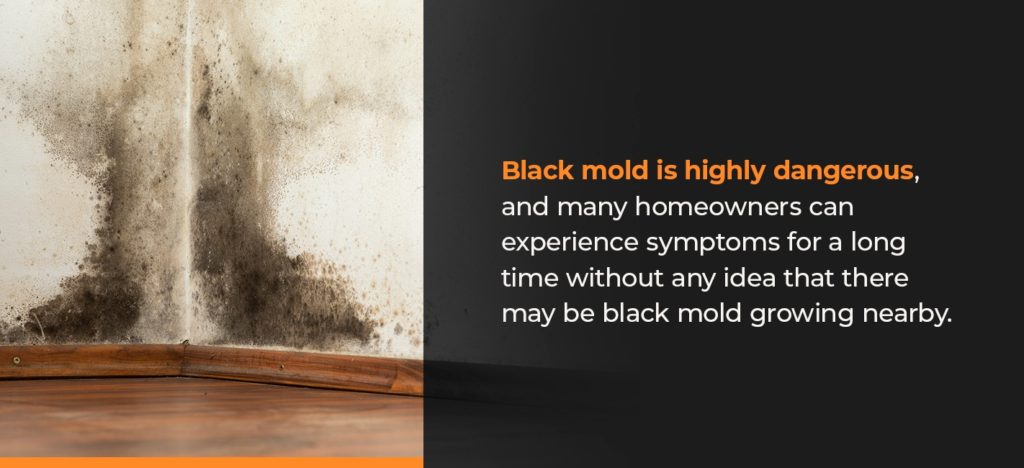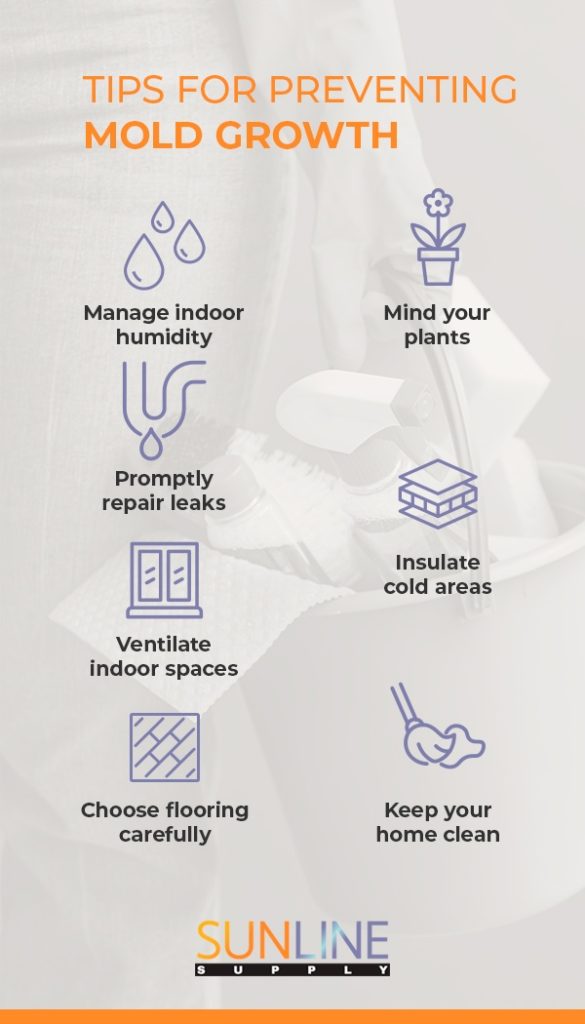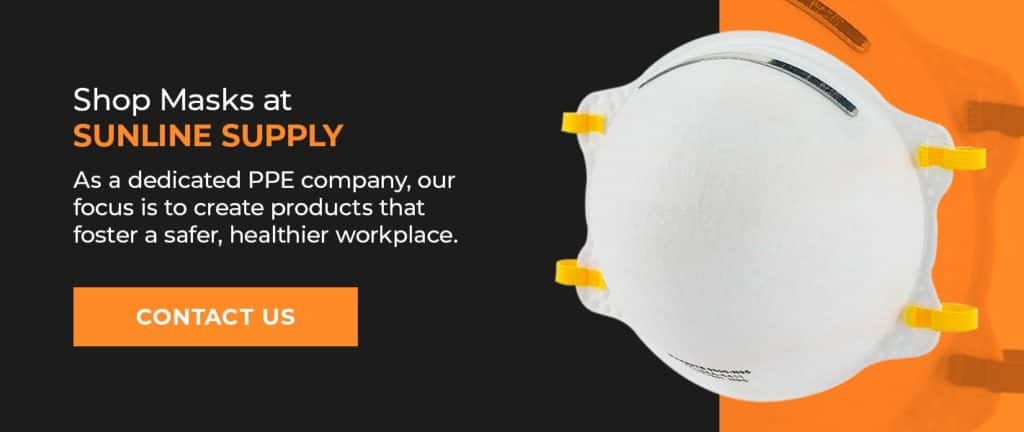
Best Mask to Protect Against Mold
Mold spores are all around you — indoors, outdoors, in your carpet, on your plants — and may pose a severe threat to your health. If you work in an environment with an increased chance of mold exposure, like construction or natural disaster relief, you must wear protective equipment to keep you safe from inhaling mold.
Best Masks to Prevent Mold Inhalation
The best mask for cleaning mold is an N95 respirator. N95 respirators are a type of particulate mask with a built-in filtration system that — when fit securely against your face — will prevent small mold particles from reaching your nose and mouth. They are also the only mold mask approved by the National Institute for Occupational Safety and Health (NIOSH).
Three protection levels are available for N95 respirators, depending on the extent of your project or mold concerns.
- Minimum: Minimum masks are suitable for minor mold remediation tasks in contaminated areas 10 feet or smaller.
- Limited: Limited respirators are either half or full-face masks with air-purifying abilities. Their P100 filter makes them ideal for spaces between 10 and 100 feet in area.
- Full: Full-face respirators are for extreme mold protection in spaces 100 feet or larger. They help purify the air you breathe while protecting you from spores.
Some N95 respirators have an exhalation valve to make it easier to breathe. These valves do not alter the mask’s safety and provide just as much protection against mold. The exhalation valve might even help you stay safer and more comfortable while working, making these masks ideal for commercial and industrial work. However, due to the nature of the valve, you cannot use these types of respirators in sterile conditions, such as medical offices or surgical rooms.
N95 respirator masks do not protect against gases and chemicals. If you’re working on a construction project or in an area with severe mold growth, you should also wear disposable gloves and protective goggles for further protection. Never tackle a mold project unprotected.
What Is Mold?
Mold is a common, natural occurrence. It plays an integral part in the natural order of decomposition outdoors. Indoors, however, it can ruin furniture, irritate existing health conditions and spread quickly. Mold colonies grow from small mold spores in the air that can cling to you or objects and make their way into your home. They can remain active for years after they form a colony and have allergenic properties even when dormant.
Mold takes different shapes and colors, depending on the type. The most prevalent types of mold are as follows.
- Cladosporium: With hundreds of different species, Cladosporium is a widespread household mold. It’s usually black, green or brown. Though generally harmless, it can irritate asthmatic symptoms.
- Penicillium: Penicillium has several beneficial uses, depending on the species, but some are harmful airborne toxins commonly associated with spoiled food. Penicillium is often blue, green, or yellow.
- Aspergillus: Aspergillus is another mold with hundreds of species, many of which can be extremely dangerous, even in small amounts. Aspergillus is white, yellow, or both.
- Stachybotrys chartarum: Stachybotrys chartarum, more commonly known as black mold, is greenish-black and the most harmful mold that grows in homes, businesses, and other structures. Black mold causes a range of unpleasant side effects, including life-threatening ones, and is especially dangerous to infants.
- Mildew: Mildew is similar to mold and forms colonies under the same wet, humid conditions. Fabrics, bathrooms, surfaces, tiles, and furniture are particularly susceptible to mildew growth. As an ashy or white substance, it resembles some mold types but is a surface fungus that is relatively harmless and easy to wipe away with a cleaning agent.
Look for mold in wet or humid environments, including the basement, bathroom, kitchen or crawl space. In industrial settings, check anywhere with stacked cardboard boxes or where possible leaks may occur.
What Mold Is Dangerous to Breathe?

Black mold is highly dangerous, and many homeowners can experience symptoms for a long time without any idea that there may be black mold growing nearby. Keep in mind that black mold, as in the toxic Stachybotrys chartarum, is not the only mold that takes on a dark hue. You might have a harmless type of black-colored mold. However, it’s equally possible that it’s toxic black mold, which is why it’s crucial to contact a professional. Toxic black mold is harmful, especially to those with weakened or vulnerable immune systems.
Possible symptoms vary in different people, some more severe than others. Common symptoms include:
- Rashes or lesions on the skin.
- Difficulty breathing.
- Swelling or redness.
- Sudden pneumonia or sinusitis.
- Persistent cold and flu-like symptoms.
- Chronic cough with mucus.
- Headaches.
- Itching, swollen or irritated eyes.
- Nausea and vomiting.
- Bleeding in the lungs.
- Various neurological and mental conditions and disorders.
Of course, toxic black mold is not the only unsafe type — it’s merely the most dangerous. Always wear a mask with a filter cartridge and air-purifying capabilities when handling or working near mold of any kind.
Where and When Mold Grows
Mold can grow virtually anywhere, but it proliferates in wet and humid areas. Some of the most common culprits for growth are cardboard and paper products, carpet, insulation and wood.
Not sure if mold is present? Check for these signs:
- You notice an abnormal or “off” smell, especially when the air conditioner is on.
- You’re feeling constant cold-like symptoms that linger or recur.
- You see visible discoloration on walls, floors, furniture and surfaces.
- You have sudden difficulty breathing.
- Carpets, rugs or furniture feel inexplicably damp, despite no visible water or spills.
Mold After Natural Disasters
Hurricanes, tornadoes, flash floods and even snowstorms leave behind more than property damage. They also create ideal mold-growth environments. Whether you’re a part of a natural disaster relief organization or a homeowner trying to rebuild, here are some things to know about mold in these situations:
- Once it is safe to do so, remove all standing water indoors and discard any water-damaged furniture, flooring or walls.
- When working indoors, open windows and doors, even if there doesn’t seem to be much mold, so you can breathe safely. Turn on a fan to circulate air around the space.
- Be careful when mixing bleach-cleaning chemicals. Some combinations, like bleach with ammonia, are dangerous.
- If you live somewhere with frequent natural disasters, like in a hurricane zone, consider seeking an insurance policy that may offset the cost of mold damage in your home or business.
- Contact a physician after mold exposure, no matter how minimal. If you encounter toxic black mold or other dangerous fungi, vacate the area immediately and contact a professional for further instruction.
When to Wear a Mold Mask
Mold can thrive anywhere, even in brand-new homes and office settings. However, some circumstances are more likely to expose you to mold than others. If you work in the following projects or industries, you should always have a high-quality mold mask on hand:
- Building, renovating or tearing down a house or structure.
- Cleaning out a basement or crawl space.
- Cleaning up after a natural disaster, even outdoors.
- Stripping and removing wallpaper.
- Any small or large-scale construction project.
- Construction and demolition professionals who take on multiple projects at once.
- Installing or breaking down walls and flooring.
- Food cleanup and messy kitchen environments.
If you deal with mold as a part of your everyday job, have multiple masks or work with a supplier to keep them stocked for you and your crew. Always dispose of and replace each N95 respirator mask for mold according to package instructions or required safety guidelines.
Why Wear Masks for Mold?
People at the highest risk for mold sickness are those with existing conditions that make them more vulnerable to illness, like those with allergies, asthma, immune suppression, lung disease, respiratory challenges and cardiac disease. Some people, like infants and older adults, are also at a higher risk. However, toxic mold can make even the healthiest people sick or symptomatic.
Wearing a mask around mold, particularly an N95 respirator, is the best line of defense against unpleasant or life-threatening side effects. The integrated filtration system will capture and block harmful mold spores, preventing inhalation. Some types of respirators even bring you clean, purified air to inhale, while expelling the contaminated air.
Masks are an easy, effective method of protection, and they might even be a legal requirement, depending on your job or workplace recommendations.
Tips for Preventing Mold Growth

Once mold spores infiltrate your home, they can form a colony in as little as one day. Preventing mold growth is the best form of defense.
Keep your home or business mold-free with these tips.
- Manage indoor humidity: Ideally, humidity in your home should be between 30 and 50%. Use dehumidifiers and air conditioners to keep air flowing and humidity in the safe range.
- Promptly repair leaks: Identify leaks and fix them immediately, especially in small and non-ventilated spaces. Promptly remove and dry all standing water.
- Ventilate indoor spaces: Ventilation and circulating airflow keep things dry and aerated to minimize mold growth. These include basements, attics, crawl spaces and garages.
- Choose flooring carefully: Choose your flooring carefully. Avoid carpeting rooms that get wet or humid easily, like the bathroom. Whenever possible, opt for area rugs instead. Vacuum often.
- Mind your plants: Overwatering isn’t only harmful to your plants, but it could also harbor mold colonies. Inspect your plants often, including the leaves and soil, and take steps to dry or replace dirt if necessary.
- Insulate cold areas: Avoid condensation moisture by keeping your home warm in colder temperatures and insulating all cold surfaces, including walls and around window panes.
- Keep your home clean: The cleaner your house is, the less opportunity mold has to thrive. It will also be easier for you to spot possible growth or leaks. Wipe surfaces often and allow them to air dry. Never leave damp furniture, rugs, clothes or towels on the floor.
How to Properly Wear Mold Protective Equipment
A mask is only useful against mold spores if it consists of high-quality, durable materials and fits correctly against your face. Always follow all instructions and guidelines on the packaging and test the fit by following these steps:
- Wash and dry your hands before handling your N95 respirator.
- Make sure the mask fits securely against your face without digging or creating gaps.
- Check the fit by exhaling while wearing the mask and using your hands to feel for any air escape. Readjust as needed.
If you have a medical condition that makes it difficult to breathe, like asthma or heart conditions, consult your doctor before wearing a respirator. If you feel dizzy, faint or can’t catch your breath at any point while wearing the mask, seek a ventilated area and remove the mask immediately.
Masks That Do Not Offer Personal Protection From Mold Pollution
Most masks offer little to no protection against mold, especially if they don’t sit securely on your face without gaps. For your safety, avoid the following:
- Dust masks
- Surgical masks
- Knit masks
- Cloth masks
- Costume masks
- Bandanas
- Face shields
If you need masks with particulate filters that remove more than mold, look for something like an N99 or N100 respirator. They are similar to the N95 respirator, but filter most gases and chemicals as well as toxic mold spores.
Tips for Wearing a Mask
Wearing a mask may seem simple enough, but you should know a few things if you want to stay comfortable and safe as you remove mold.
- Stay safe: If you have trouble breathing or a medical condition that makes masks detrimental to your well-being, talk with your doctor before wearing one. If you’re asthmatic, always have your prescribed inhaler on hand while working in a respirator.
- Pause often: While wearing the mask, take frequent breaks to avoid overheating. Seek places with fresh air, preferably outdoors, and remove the mask carefully. Remember to stay hydrated.
- Seek assistance: For extensive mold removal, contact an experienced professional. They will come equipped with the tools, protective equipment and knowledge needed to safely remove all growth and give you tips for preventing future outbreaks, if necessary.
Shop Masks at Sunline Supply
If you need protective equipment for your worksite or office, Sunline Supply has you covered. As a dedicated PPE company, our focus is to create products that foster a safer, healthier workplace. We use nothing but high-quality materials and expert craftsmanship to create PPE for the health care, industrial, commercial and educational sectors. Every Sunline Supply factory and product has received approval from the FDA.
Our N95 9500 masks meet the stringent safety standards of NIOSH, the FDA and CE. They consist of non-woven fabrics, with comfortable interior nose clips for a secure fit. You can use them for daily protection and in toxic mold environments.
Learn more about PPE from Sunline Supply and start your order today.

Want to Learn More? Check out These Additional Posts
-
When to Change Your N95, KN95, or Surgical Masks
Recent supply chain shortages have continued to limit the availability of N95 masks around the country. The healthcare facilities that need them the most, along with construction and other industrial workplaces, still find a shortage of these critical personal protective equipment (PPE) devices. As demand surges, manufacturing bottlenecks keep masks in short supply, making it…
-
What Masks Work Against Silica Dust?
Respirable crystalline silica, or silica dust, is an assortment of airborne particles caused by working with materials containing crystalline silica. Manufacturing and construction industry workers are often exposed to these particles when drilling or grinding various materials, including concrete, stone and brick. Provide the best dust masks for silica to protect your employees from these…
-
KN95 vs. N95 Masks: Do They Protect Differently?
Masks are one of our greatest assets in the fight to slow the spread of airborne infectious diseases. It’s surprising just how much a layer of fabric can do to increase public health and safety and create safe workspaces. In the last year, N95s have become ubiquitous throughout healthcare environments. However, they’re also a popular…

